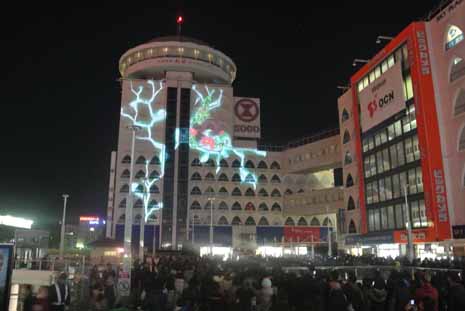Inter BEE 2014: The Projection Mapping Association of Japan makes their first Inter BEE appearance; will introduce event examples and demo projection mapping
2014.11.6 UP

■Showcasing mapping examples and doing a simple demonstration
The Projection Mapping Association of Japan (PMAJ) set up a booth at Inter BEE for the first time this year with goal of familiarizing people with, and enlightening them on, projection mapping.
PMAJ spokesperson, Michi Ishita, elaborated, “For several years now, the words ‘projection mapping’ have been popularized and have even been used for many year in domestic marketplaces. Even the broadcasting industry has incorporated projection mapping into their programs and the number of broadcaster-related mapping events has grown immensely. At Inter BEE, we will introduce some examples of the main mapping events that we have put on through some video footage. We also plan to combine that with a simple mapping demo. Please stop by our booth.”
■2012: The year projection mapping began in Japan
Projection mapping (PM) was mainly developed in Europe, specifically France and England, but in 2010, Michiyuki Ishita started to put on PM events in Japan (still ongoing as of 2014), mostly in Zushi City, Kanagawa and started the PMAJ. In July of 2012, the group was changed into that of a general incorporated foundation (industry group) mainly for image and CG creators. The PMAJ was established.
After being incorporated in 2012, they started putting on large-scale PM events, such as the one at Tokyo Station, and became a big topic of discussion.
■The first example in Japan was 20 years ago and used a film projector
The first example of PM in Japan is thought to have taken place at the Ebisu Garden Place in Ebisu, Tokyo as part of the opening events for the Tokyo Metropolitan Museum of Photography and was supervised by a French artist. At that time, they did not use the same digital projectors that we do now, but rather they screened film through a French-made PIGI high-luminance slide projector. In Europe, they still currently utilize this kind of film projector for many PM projects.
Around 10 years ago, they used a Barco high-luminance projector for many uses during the “Hikari no Sho” event, which was part of the opening events for the Yuraku-cho Marui Itocia. This kind of event can still be considered what is now PM.
■Imaging techniques that synchronize the real and the virtual
Mr. Ishita had the following to say about the charms of PM.
“PM is a way of synchronizing the real and the virtual. It is not simply projecting an image on a surface. Its main distinction is using projectors, and the like, to project things onto three-dimensional objects, such as buildings and furniture, as well as uneven surfaces.
You have to match the three-dimensional data, or surface data, to what will become the screen and image materials, so that when you do the projection, everything overlaps perfectly. Then when the image moves or is altered, the projected figure moves or is transformed, or, of course when light is cast down giving it a magical effect, it provides a sort of optical illusion.
Through mapping (pasting imaging materials to the surface of the projection object), we can take the measurements of the object’s parts/uneven areas and three-dimensionally project lights and shadows onto it in order to enhance it with a completely different look. Moreover, we can take something that we would never expect to move, give it a sense of space and three-dimensionality, and make it seem like it is really moving.”
The Projection Mapping Association of Japan:
6th Fl., Kasumigaseki-MH-Towers, 3-6-15 Kasumigaseki, Chiyodaku, Tokyo 100-0013, Japan
URL:http://www.projection-mapping.jp
Video/Broadcasting Equipment Category /Hall 3 /3309









